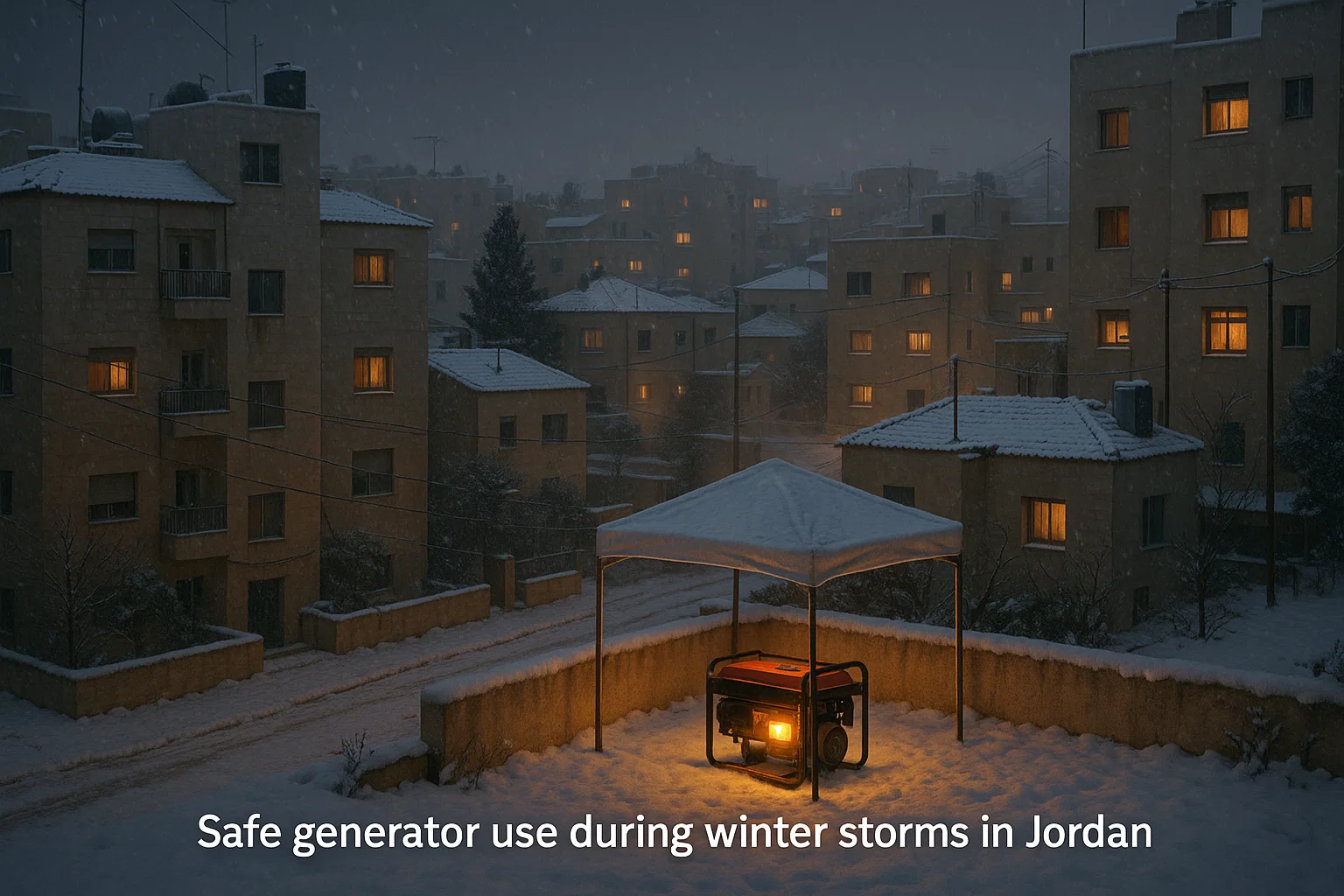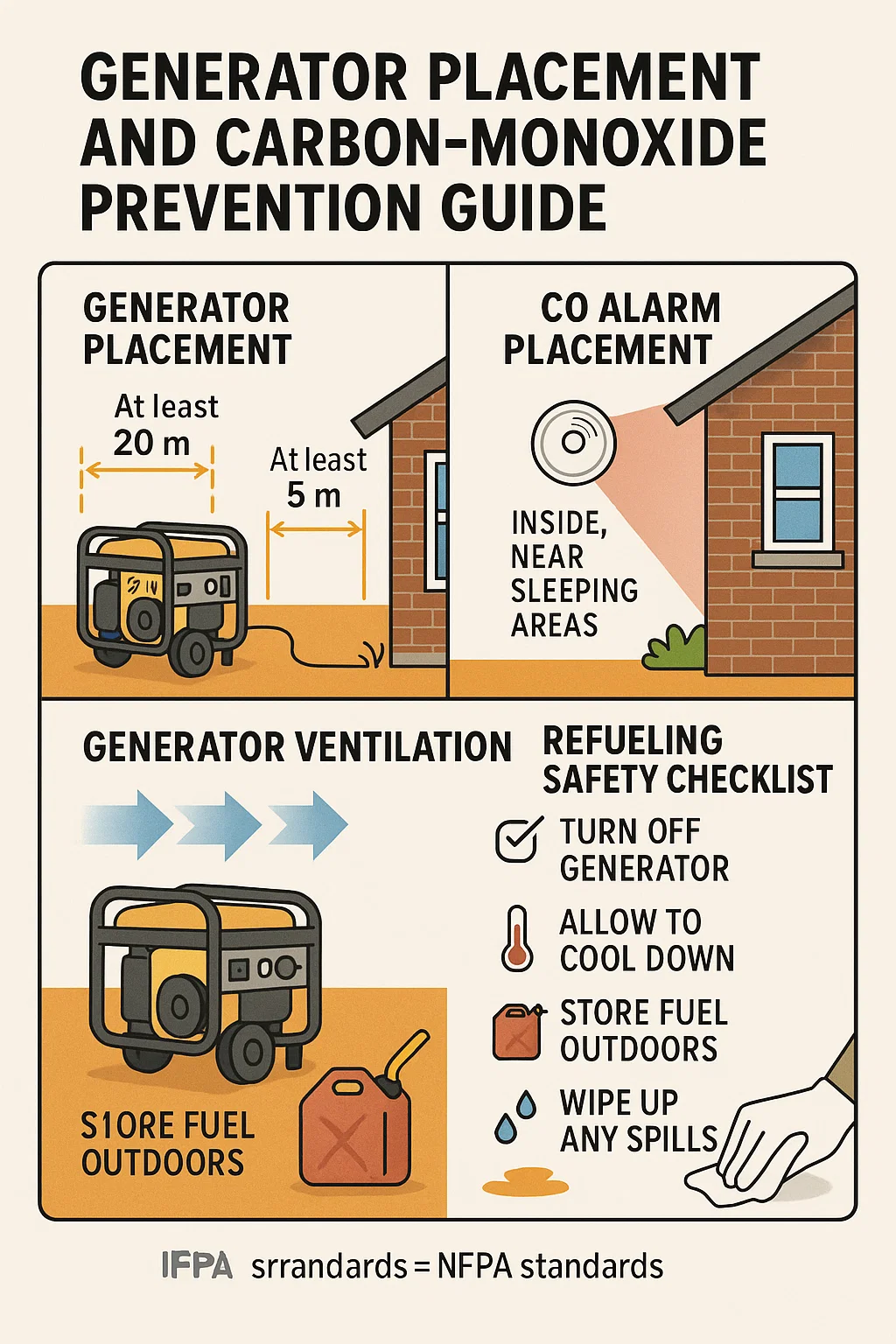
Unlike short blackouts in summer, cold-season outages threaten both survival and safety. Without electricity, families rely on generators, kerosene heaters, and candles all potential ignition or carbon-monoxide hazards.
According to the Jordan Civil Defense Directorate (JCD), most winter-related fire or CO incidents occur within the first 12 hours after a storm cuts power. The combination of poor ventilation, faulty cords, and hurried generator setups turns otherwise safe homes into danger zones.
This guide gives responders and citizens alike field-tested strategies based on NFPA 70, NFPA 110, OSHA 1910.305, and JCD winter advisories to keep power flowing safely through the coldest nights.
Operational Context Why Power Outage Risks Increase in Winter
1. Limited Ventilation & Sealed Homes
Modern homes in Jordan are tightly sealed for warmth. When a portable generator or charcoal heater runs in a garage or balcony alcove, exhaust gases build rapidly. Within minutes, CO levels can exceed 400 ppm, enough to cause unconsciousness.
2. Improvised Electrical Connections
During emergencies, families often “back-feed” power by connecting a generator directly into a wall socket an NFPA 70 violation that endangers both users and utility linemen.
3. Flammable Fuel Storage
Diesel and gasoline cans stored indoors or near heat sources increase ignition risk. Statistics from JCD (2024) show one in five winter house fires originates near a heating or generator fuel container.
4. Overloaded Circuits
Old apartment blocks in Amman and Zarqa often use 10-amp circuits. Plugging multiple heaters into a single extension cord can melt insulation within 15 minutes.
Emergency Procedures Response Steps for Households and Responders
When a storm strikes, time and clarity matter. The sequence below follows Incident Command System (ICS) logic adapted for home and community scale.
Step 1 Initial Size-Up & Safety Assessment
- Confirm outage cause via official radio or JCD alerts.
- De-energize main breakers before connecting any generator.
- Check occupants for CO symptoms (headache, nausea, dizziness).
- Ventilate: open windows 2–3 cm even in cold weather to allow air exchange.
Step 2 Generator Deployment Checklist
| Item | Specification / Safety Standard | Field Note |
|---|---|---|
| Location | 6 m (20 ft) from windows – NFPA 37 § 4.1.4 | Never in garage or balcony niche |
| Grounding | Bond frame to grounding rod – NFPA 70 § 250 | Reduces shock hazard |
| Fuel Type | 91 octane petrol or diesel only | No kerosene mixes |
| CO Sensor | Must include auto-shutoff CO monitor (ANSI Z21.10.1 2023) | Required in new models |
| Load Rating | 5 kVA max per home circuit | Prevents wire overheating |
| Refueling Rule | Cool ≥ 15 min before refill | Avoid fuel vapor ignition |

Step 3 Hazard Control and Monitoring
- Use CO alarms near bedrooms and generator access points.
- Replace extension cords rated below 13 amps.
- Keep fire extinguishers (Class B/C) accessible CO₂ type preferred.
- Conduct hourly visual checks on cable heat and generator exhaust.
Pro Tip #1: Label fuel cans with date and type. Fuel older than 60 days loses volatility and clogs carburetors a leading cause of generator backfires.
Step 4 Triage and Medical Response
If residents show CO poisoning signs:
- Move to fresh air immediately.
- Call 911 / 199 (JCD Hotline).
- Provide high-flow oxygen if available; transport to nearest hospital with hyperbaric capability (e.g., King Hussein Medical Center).
Step 5 Overhaul & Demobilization
After power restoration:
- Let generators run unloaded 5 min to stabilize before shutdown.
- Inspect cords for scorch marks.
- Drain fuel if storage > 30 days planned.
- Log incident data for community training records.
Pro Tip #2: Store printed generator diagrams inside a transparent plastic sleeve attached to the machine saves time for responders unfamiliar with model layout.
Equipment & Tools
Specs & Selection
| Equipment | Capacity / Range | Compliance Reference | Notes |
|---|---|---|---|
| Portable Generator (5 kVA) | 120/240 V, single-phase | NFPA 110 Type 10 Class 1 Level 1 | CO-sensor and surge protection required |
| Extension Cords | 12 AWG min, weather-rated | OSHA 1910.305(g) | Avoid coiled cords; they retain heat |
| CO Alarm | 30–70 ppm alert range | EN 50291 / JCD approved | Test weekly during winter |
| Fire Extinguisher | 2 kg CO₂ or 3 kg dry chemical | NFPA 10 | One per floor recommended |
| Fuel Container | Metal UN certified, ≤ 20 L | UN 1203 code | Keep ≥ 1 m from heater |
Inspection, Donning / Doffing, Maintenance Cycles
- Weekly: Test run generator for 10 min under half load.
- Monthly: Check oil level, CO alarm battery, cord integrity.
- Seasonal: Replace spark plug, clean air filter, drain stale fuel.
- After Each Use: Allow cool down → cover with breathable fabric to avoid condensation damage.
Field Scenarios & Case Applications
Recent Patterns (2023–2025)
- 2023 Amman Blizzard: Power outages up to 36 hours; JCD reported 11 CO cases, 2 deaths from indoor generator use.
- 2024 Ajloun Ice Event: Rural families improvised heater connections with bare wires, causing electrical fires in four homes.
- 2025 Madaba Wind Storm: Successful deployment of community generator stations reduced household hazards by 70%.
Innovation Trends
- CO-sensing shut-off generators (ANSI Z21.10.1 2023).
- Smart load balancers that auto-limit draw per circuit.
- Hybrid battery modules for quiet indoor power needs (< 300 W).
Training & Safety Guidelines
Drills and Communication
- Conduct pre-winter community drills with Civil Defense observers.
- Apply plain-language ICS communication: “Generator out,” “CO alert,” etc. Avoid codes for public clarity.
- Use LUNAR reports (Location, Unit, Name, Assignment, Resources needed) for responder tracking.
- Enforce PAR (Personnel Accountability Report) every 30 minutes during storm operations.
Community Education Focus
- Distribute illustrated leaflets in Arabic + English.
- Demonstrate 6 m generator distance rule in neighborhood campaigns.
- Encourage families to keep two fire extinguishers and one CO alarm per apartment.
Pro Insights (Box) What Pros Actually Do
- Always test CO detectors before starting a generator.
- Use a ground-fault circuit interrupter (GFCI) for any outdoor power line.
- Keep generator exhaust facing downwind from living areas.
- Never refuel while engine runs or surface is hot.
- Log fuel usage and maintenance hours in a notebook.
- Store generator keys in an easy-to-reach spot near the exit.
- Coordinate with neighbors to share one larger safe unit instead of multiple unsafe small ones.
- After storm events, submit near-miss reports to local Civil Defense for trend tracking.
FAQs
Q1: Can I run a generator on a balcony if doors and windows are closed?
No. Wind currents can pull exhaust indoors. Keep at least 6 meters away from any opening.
Q2: How long can I store fuel for my generator?
Up to 60 days in a sealed metal container. Add stabilizer if stored longer.
Q3: What are CO poisoning symptoms to watch for?
Headache, nausea, dizziness, and confusion. Seek fresh air and medical help immediately.
Q4: Is back-feeding my house panel illegal in Jordan?
Yes. It violates NFPA 70 and JCD codes because it can energize lines and shock utility workers.
Q5: What should I do if my CO alarm goes off during a storm?
Shut off the generator, evacuate, call 199, and wait for responder clearance before re-entry.

Alex Smith, a seasoned medical technician with 15 years in ambulance services, writes crucial first-aid tips and emergency care insights on arescuer.com.
